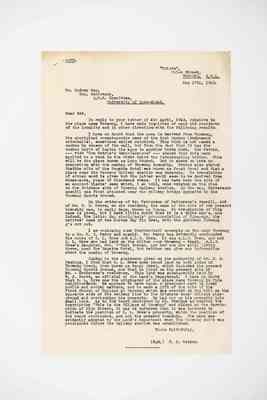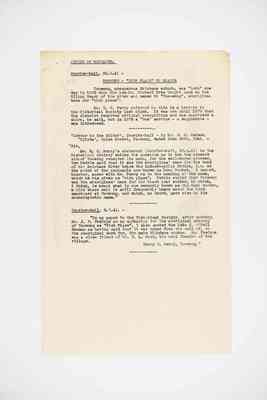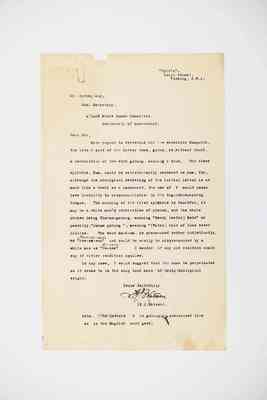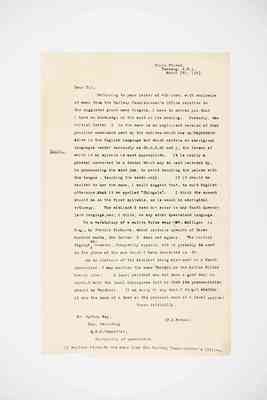Pages
16
COPY:
"Nyleta", Union Street, TOOWONG. S.W.1. May 17th, 1943.
Mr. Sydney May, Hon. Secretary, Q.P.N. Committee, University of Queensland.
Dear Sir,
In reply to your letter of 4th April, 1843, relative to the place name Toowong, I have made inquiries of many old residents of the locality and in other directions with the following results.
I have no doubt that the name is derived from Toowong, the aboriginal onomatopoe name of the Koel Cuckoo, (Endynamys orientalis), sometimes called rainbird. This bird is not named a cuckoo by reason of its call, but from the fact that it has the cuckoo habit of laying its eggs in another birds nest. Tom Petrie, ---vide "Tom Petrie's Reminiscences"--- stated that this name applied to a bend in the river below the Indooroopilly bridge. This will be the place known as Long Pocket. But it seems to have no connection with the naming of Toowong township. Petrie also stated that the site of the Regatta Hotel was known as Jo-ai Jo-ai and that a place near the Toowong Railway station was Bunaraba. No translation of either word is given but the latter would seem to be derived from Bunar-a-ba, place of bloodwood trees. It may have been the site of an ancient blacks' camp which, I am told, once existed on the rise on the Brisbane side of Toowong Railway station. By the way, Patterson's sawmill was first situated near the railway bridge opposite to the Toowong Sports Ground.
On the evidence of Mr. Patterson of Patterson's Sawmill, and of Mr. E. B.Pears, and old resident, the name of the site of the present township was, in early days, known as Noana. No translation of this name is given, but I have little doubt that it is a white man's, and indeed, the latter day aboriginals' pronounciation of Ngoa-nga, the natives' name of the Moreton Bay fig tree, with the gutteral forming g's cut out.
I am enclosing some Courier-Mail excerpts on the name Toowong by a Mr. H. C. Perry and myself. Mr. Perry has evidently confounded the names of R. L. Drew and A. L. G. Drew. It was A.L.G. Drew, and not R. L. Drew who had land on the Milton --or Toowong - Reach. A.L.G. Drew's daughter, Mrs. O'Neil Brenan, and her son are still living there, near the Regatta Hotel, but neither can give any information about the naming of Toowong.
Coming to the statement given on the authority of Mr. J. B. Fewings, I find that R. L. Drew once owned land on both sides of Toowong Creek, then known as Sandy Creek, which included the present Toowong Sports Ground, and that he lived on the present site of Mr.--Henderson's residence. This land was subquently held bt W. J. Scott, an official of the Land's Department. I have no doubt that R. L. Drew was the originator of the place name Toowong in this neighbourhood. He appears to have taken a prominent part in local public and social matters, and he made a gift of the site of the first Church of England at Toowong which was erected on the hill on the opposite side of the railway line to the Brisbane Boys' College playground and overlooking his property. He had cut up his property into small lots. As to the board mentioned by Mr. Fewings as bearing the inscription "This is the Village of Toowong" and placed at the termination of High Street, it may be inferred that it was intended to indicate the position of R. L. Drew's property, which the position of the board overlooked, and not the present township. The name was evidently adopted by the Lands Department when the Toowong Shire was proclaimed before the Railway station was established.
Yours faithfully,
(sgd.) [F. J. Watson]. ---------------------
17
COPIES OF EXTRACTS:
Courier-Mail, 25.6.41 -
TOOWONG - "RICH PLACE" TO BLACKS
Toowong, prosperous Brisbane suburb, was "born" one day in 1862 when the late Mr. Richard Drew bought land on the Milton Reach of the river and named it "Too-wong", aboriginal term for "rich place".
Mr. H. C. Perry referred to this in a lecture to the Historical Society last night. It was not until 1879 that the district received official recognition and was appointed a shire, he said, but in 1872 a "bus" service - a waggonette - was introduced.
------------
'Letter to the Editor', Courier-Mail - by Mr. F. J. Watson, "Nyleta", Union Street, Toowong, dated June 25th, 1941. -
"Sir,
Mr. H. C. Perry's statement (Courier-mail, 25.6.41) to the Historical Society solves the question as to how the present site of Toowong received its name, for the well-known pioneer, Tom Petrie said that it was the aborigines' name for the bend of the Brisbane River below the Indooroopilly Bridge, i.e. at the point of the peninsula now known as Long Pocket. I cannot, however, agree with Mr. Perry as to the meaning of the name, which he has given as "rich Place". Petrie stated that Toowong was the aborigines' name for the black goat sucker, by which, I think, is meant what is now commonly known as the Koel cuckoo, a bird whose call is still frequently heard about the bird sanctuary at Toowong, and which, no doubt, gave rise to its onomatopoetic name."
------------
Courier-Mail, 2.7.41. -
"In my paper to the Historical Society, after quoting Mr. J. B. Fewings as my authority for the aboriginal meaning of Toowong as "Rich Place", I also quoted the late J. O'Neil Brenan as having said that it was named from the call of, or the aboriginal word for, the male Flinders cuckoo. Mr. Fewings was a close friend of Mr. R. L. Drew, the real founder of the village.
------------
18
"Nyleta". Union Street, Toowong, S.W.1.
Mr. Sydney May, Hon. Secretary, Q'lqnd Place Names Committe, University of Queensland.
Dear Sir,
With regard to Grassdale and the waterhole Eumgubba, the lateer part of the latter name, gubba, is,without doubt, a contraction of the word gubung, meaning a hole. The first syllable, Eum, could be satisfactorily rendered as yum, for, although the aboriginal rendering of the initial letter is as much like a vowel as a consonant, the use of Y would cause less liability to mispronunciation by the English-speaking tongue. The meaning of the first syllable is doutful, it may be a white man's contraction of yimbun, and the whole phrase being Yimbun-gubung, meaning "Reedy (water) hole" or possibly,"Muium gubung", meaning "(Water) hole of blue water lillies. The word Mu-i-um, is pronounced rather indistinctly, as "Moo-ee-oom"[correction of Moo-se-oom] and could be easily be mispronounced by a white man as "Ee-oom" [correction of Ee-oom] I wonder if any old resident could say if either condition applies.
In any case, I would suggest that the name be perpetuated as it seems to be the only land mark of truly aboriginal origin.
Yours faithfully FJWatson (F. J. Watson).
Note. The letters U in gubung are pronounced like oo in the English word good.
19
Union Street, Toowong, S. W. 1. March 10th, 1943.
Dear Sir,
I have your letter of 8th inst. to hand. With regard to my aboriginal vocabulary compilation, I am sorry that I cannot comply with your suggestion that I should exhibit it to the University Librarian as I have already placed it in the hands of Mr.D.A.O'Brien, the Secretary of the Royal Geographical Society. I had been approached on the matter by some members of the Society and as it seemed to be the only way to have it printed and recorded by a scientific or erudite body, I agreed to present the Society with it. I might mention that since the mention of the matter in the Press, quite a number of people have taken an interest in it and I have been frequently congratulated on my action. I shall not be able to see you this week, but hope to call on you some day next week.
Yours faithfully, F J Watson.
Mr Sidney May, University of Queensland, Brisbane.
20
Union Street, Toowong, S. W. 1. March 5th, 1943.
Dear Sir,
Referring to your letter of 4th inst. with enclosure of memo from the Railway Commissioner's Office relative to the suggested place name Singola, I have to advise you that I have no knowledge of the word or its meaning. Probably, the initial letter S in the name is an anglicised version of that peculiar consonant used by the natives,which has no representative in the English language but which writers on aboriginal languages render variously as dh, t, d, eh and j, the former of which in my opinion is most appropriate. It is really a palatal converted to a dental which may be best imitated by, in pronouncing the word jam, to avoid touching the palate with the tongue , touching the teeth only. If it should be decided to use the name, I would suggest that, to suit English utterance, that it be spelled "Dhingola". I think the accent should be on the first syllable, as is usual in aboriginal orthoepy. The sibilant S does not occur in any South Queensland language, nor, I think, in any other Queensland language.
In a vocabulary of a native tribe near Mt. Mulligan in N. Q., by Francis Richards, which contains upwards of three hundred words, the letter S does not appear. The initial digraph, ch- however, frequently appears, and is probably is used in the place of the one which I have described as dh.
As an instance of the sibilant being miss-used in a North Queensland, I may mention the name Tarzali, on the Millaa Millaa branch line. A local resident who had been a good deal in contact with the local aborigines told me that its pronunciation should be Tardhali. (I am sorry to say that I forget whether it was the name of a tree or the personal name of a local native.)
Yours faithfully,
(F. J. Watson).
Mr. Sydney May, Hon. Secretary, Q. P. N. Committee, University of Queensland.
(I enclose herewith the memo from the Railway Commissioner's Office).
[left margin] Enclo.




